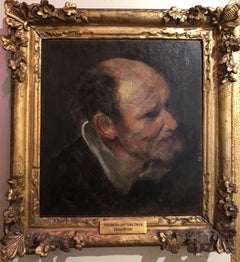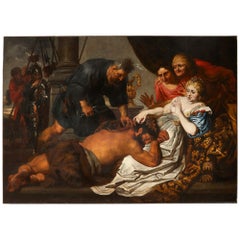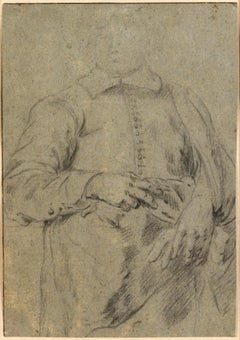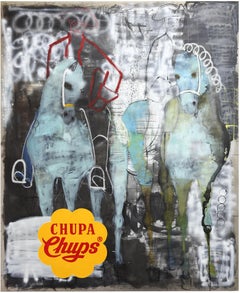Anthony Van Dyck Art
Flemish, 1599-1641
A three-quarter length portrait of Anne, Lady Russell, later Countess of, Attributed to Sir Anthony Van Dyck.
Anne Carr, Lady Russell, an esteemed beauty was clearly a favourite of Sir Anthony Van Dyck. There are six portrait types of Lady Russell listed in Miller, et al. It is tempting to associate the current portrait with the three-quarter length in blue in the Egremont collection at Petworth House (Millar IV.22) because of the similarity of colouring. However, we believe that this picture represents a different portrait type, and most likely derives from a separate sitting. The comparison with the short three-quarter length belonging to the Tokyo Fuji Art Museum, Tokyo (Millar IV.23), is telling. The heads are essentially the same, though the pose and the colouring of the portraits are quite different. The Japanese painting features a rose-red gown and a fawn stole, possibly darker than in this painting. This comparison also illustrates Van Dyck's ability to develop different compositions from a single sitting.
Dr. Malcolm Rogers CBE FSA believes this painting to be an unfinished work by the artist:
"with, as you might expect, preparatory work by a member of his studio. Especially encouraging is the penumbra of thicker paint around the lady's head which is a recognised feature associated with the artist's ad vivum rendering of heads. My notes do not mention a similar penumbra in the Tokyo painting, though the painting is throughout of very high quality. There are one or two slight pentimenti in the silhouette of the figure of your painting and in the line of her stole, which at one point may have been intended to run over her right wrist. Close examination may reveal more. Some areas of the draperies, especially the linens are not fully realised, and, of course, the background is only roughed in.
Millar suggests that the Tokyo painting with its loose gown and protective hands may indicate that the sitter is pregnant. The gown is similarly loose in [this] painting. If she is indeed pregnant this might suggest a date around 1638 or 1639, in which years the first two of her eleven children were born. I cannot explain why the painting was left unfinished, but it is, must be, a distinct possibility that this is the very portrait of Lady Bedford that remained in Van Dyck's studio at the time of his death (see C. Brown and N. Ramsay, 'Van Dyck's Collection: Some New Documents', Burlington Magazine, Vol. 132, pp. 704-9)."
Dimensions: 53 1⁄8 in (H) x 43 1⁄4 in (W)
Provenance: Picture probably listed in contents of van Dyck’s studio at time of death December 1641 (O. Millar, Van Dyck, A complete catalogue of the paintings, New Haven and London, 2004, under no. IV.23);
The most Reverand Dean of Durham, possibly William Lake (1817-1897);
Charles Sedelmeyer, 1906, as 'Sir Anthony van Dyck';
Colonel Edward F Simms of Kentucky;
H. Kenneth Franzheim;
Kenneth Franzheim II;
Thence by descent to Sabrina Franzheim (current owner).to
1
2
1
Overall Width
to
Overall Height
to
3
2
2
1
3
2
1
1
1
1
1
1
2
2
1
1
1
3
10,138
2,779
1,375
1,368
2
3
Artist: Anthony Van Dyck
Sir Anthony Van Dyck 17th Century Oil Painting Study of a Head of a Man
By Anthony van Dyck
Located in London, GB
Sir Anthony Van Dyck (1599-1641, Flemish)
Study of a Head of Man
Circa 1627-32, Van Dyck’s second Antwerp period
Oil on paper, laid down on canvas
Dimensions 15 x 14 inches (38.1 x 3...
Category
17th Century Old Masters Anthony Van Dyck Art
Materials
Oil
Large Antique Oil Painting of Samson and Delilah after Anthony van Dyck
By Anthony van Dyck
Located in London, GB
Large antique oil painting of Samson and Delilah after Anthony van Dyck
Dutch, 17th Century
Height 165cm, width 233cm
This very large artwork ...
Category
17th Century Anthony Van Dyck Art
Materials
Oil, Canvas
Study for a standing man
By Anthony van Dyck
Located in Paris, Île-de-France
Sir Anthony van Dyck
(Antwerp 1599 - 1641 London)
STUDY FOR A PORTRAIT OF A STANDING MAN
Black and white chalk on blue-green paper
25,4 by 13,5 cm
Provenance
Prof. Julius S. Held (...
Category
17th Century Old Masters Anthony Van Dyck Art
Materials
Chalk
$22,400 Sale Price
20% Off
Related Items
Large Horse Oil Painting. Contemporary Equestrian Oil Painting 220 x 180 cm
By Rubins J. Spaans
Located in ALP, ES
This large figurative oil painting is a reinterpretation of two paintings by John Vanderbank, A young gentleman riding a schooled horse, 1729 / Man on horseback, 1728. A unique oil p...
Category
2010s Contemporary Anthony Van Dyck Art
Materials
Canvas, Charcoal, Oil Crayon, Raw Linen, Oil, Spray Paint, Acrylic, Pencil
$2,250 Sale Price
71% Off
H 86.62 in W 70.87 in D 1.46 in
Manner of Guido Reni (1575-1642) The Prophecy of Simeon Large Antique Painting
Located in Cirencester, Gloucestershire
Artist/ School: Manner of Guido Reni (1575-1642) Italian
Title: The Prophecy of Simeon
Medium: oil painting on canvas, unframed
Painting: 21.5 ...
Category
Mid-18th Century Old Masters Anthony Van Dyck Art
Materials
Oil
$3,296
H 21.5 in W 18 in
Portrait of an Old Bearded Man
Located in Stockholm, SE
We are pleased to offer a captivating portrait, most likely painted in the late 18th century, attributed to an artist within the circle of Christian Wilhelm Ernst Dietrich. This oil ...
Category
Late 18th Century Old Masters Anthony Van Dyck Art
Materials
Oil, Wood Panel
Jean-Henri Cless (1774-1812) Portrait of a young woman, signed drawing
Located in Paris, FR
Jean-Henri Cless (1774-1812)
Portrait of a young woman in a landscape
signed "Cless fec" for fecit on the lower left
Brown ink and brown ink wash on paper
Size of the sheet : 31.5 x 22 cm
Size of the motive : 24.5 x 17 cm
very simply framed under glass without actual frame 32 x 22.5 cm
This pre...
Category
Early 1800s Old Masters Anthony Van Dyck Art
Materials
Ink, Pencil
18th Century Oil on Canvas Portrait, Major Alexander Brown in Military Uniform.
By Sir David Wilkie
Located in Cotignac, FR
18th Century Military portrait of a young officer in Napoleonic period military dress. The painting is not signed but the subject is Major Alexander Brown. The work is oil on canvas later mounted on board and presented in a fine 'Regence style' carved gilt frame. There are labels to the back referring to the subject, 'Major Brown of Trinity' and a framers trade label from Edinburgh.
A magnificent and imposing portrait of a young military officer in the prime of his life. His red uniform adorned with fine buttons, fringed epaulettes and high gilt collar. His ruddy complexion offset by his stylish hair, a quiff and swept forward to the sides as was the fashion at the time.
Sir David Wilkie RA (18 November 1785 – 1 June 1841) was a Scottish painter, especially known for his portraits, including formal royal ones, and scenes from his travels to Europe and the Middle East. He painted successfully in a wide variety of genres, including historical scenes. His main base was in London, but he died and was buried at sea, off Gibraltar, returning from his first trip to the Middle East. He was sometimes known as the "people's painter".
He was Principal Painter in Ordinary to King William IV and Queen Victoria. Apart from royal portraits, his best-known painting today is probably The Chelsea Pensioners Reading the Waterloo Dispatch of 1822 in Apsley House.
Sir David Wilkie was actually admitted in 1799 (despite only being 14) through the influence of the Earl of Leven...
Category
Late 18th Century Old Masters Anthony Van Dyck Art
Materials
Canvas, Oil, Board
$5,519
H 30.71 in W 25.6 in D 0.79 in
Fine 1700's Italian Old Master Oil Painting Portrait of St. Peter
Located in Cirencester, Gloucestershire
St. Peter
Italian, 18th century
oil on canvas, laid on panel
panel: 9.75 x 8 inches
Provenance: private collection, Paris
Condition: very good condition
For more any more informati...
Category
18th Century Old Masters Anthony Van Dyck Art
Materials
Oil
Huge Antique Oil Painting Oval Portrait of Mary Magdalene Holding Ointment Jar
Located in Cirencester, Gloucestershire
Portrait of Mary Magdalene with an Ointment Jar
Spanish School, early 20th century, unsigned
after the earlier 16th century painting by Jan van Scorel
oil on panel, framed
framed: 4...
Category
Early 20th Century Old Masters Anthony Van Dyck Art
Materials
Oil
Antique French Old Master Oil Painting Christ Healing the Sick in Jersusalem
Located in Cirencester, Gloucestershire
Christ Healing the Sick
French School, 19th century
oil on canvas, unframed
canvas: 15 x 20.5 inches
Provenance: private collection, Europe
Condition: some craquelure throughout, mo...
Category
19th Century Old Masters Anthony Van Dyck Art
Materials
Oil
$1,734 Sale Price
30% Off
H 15 in W 20.5 in
Antique French Miniature Portrait of Lady Biographical details with painting
Located in Cirencester, Gloucestershire
Miniature Portrait
French School, late 18th/ early 19th century
framed: 5.5 x 5.5 inches
board: 2 x 2 inches
provenance: private collection, France
condition: very good and sound c...
Category
Late 18th Century Old Masters Anthony Van Dyck Art
Materials
Watercolor
$1,231
H 5.5 in W 5.5 in
Antique Italian painter - 18th century figure painting
Located in Varmo, IT
Italian painter (18th century) - Chrono.
90.5 x 106 cm.
Antique oil painting on canvas, without frame (not signed).
Condition report: Lined canvas. Good state of conservation of t...
Category
Early 18th Century Old Masters Anthony Van Dyck Art
Materials
Canvas, Oil
$4,799 Sale Price
20% Off
H 35.63 in W 41.74 in
“Quebec City, 1853” Panoramic Landscape View, Cityscape, Canada Signed Oil
By Edmund C. Coates
Located in Yardley, PA
“Quebec City, 1853” by Edmund C. Coates (American, 1816-1871).
A luminous 19th-century view of Quebec City by the American painter Edmund C. Coates, known for his detailed Hudson Ri...
Category
1850s Hudson River School Anthony Van Dyck Art
Materials
Canvas, Oil
$4,500
H 31.5 in W 39 in D 2.5 in
17th Century Memento Mori Vanitas Skull Old Master Oil Ex-Christie’s
Located in Yardley, PA
This wonderful 17th-century French School vanitas painting is a meditation on mortality and the transience of earthly pleasures. The composition centers on a finely rendered human sk...
Category
17th Century Old Masters Anthony Van Dyck Art
Materials
Canvas, Oil
$6,500
H 21.88 in W 25.25 in D 1.5 in
Previously Available Items
studio of Sir Anthony van Dyck - Self Portrait
By Anthony van Dyck
Located in Gerrards Cross, GB
A fine 17th century oil on canvas portrait of the celebrated Flemish artist Sir Anthony van Dyck (1599-1651). With the exception Peter Paul Rubens...
Category
17th Century Old Masters Anthony Van Dyck Art
Materials
Oil
Anthony Van Dyck art for sale on 1stDibs.
Find a wide variety of authentic Anthony Van Dyck art available for sale on 1stDibs. You can also browse by medium to find art by Anthony Van Dyck in canvas, fabric, oil paint and more. Not every interior allows for large Anthony Van Dyck art, so small editions measuring 92 inches across are available. Customers who are interested in this artist might also find the work of Jan Frans van Bloemen (Orizzonte), Sir Godfrey Kneller, and Giovan Battista Viola. Anthony Van Dyck art prices can differ depending upon medium, time period and other attributes. On 1stDibs, the price for these items starts at $94,810 and tops out at $94,810, while the average work can sell for $94,810.
Artists Similar to Anthony Van Dyck
Questions About Anthony Van Dyck Art
- 1stDibs ExpertOctober 30, 2024How much a van Dyck painting is worth varies based on its historical significance, condition and size. At a London auction in 2009, a self-portrait of the artist sold for $13.5 million. Sir Anthony van Dyck was a Flemish Baroque artist who became the leading court painter for Charles I of England. He is best known for his portraits of royalty and aristocracy, most notably Charles I and his family and associates. His style changed considerably between the countries he worked in, culminating in the relaxed elegance of his last English period. Van Dyck widely influenced English portrait painting for the next 150 years, and his influence extended into the modern period. If you own a van Dyck piece, use the services of a certified appraiser or knowledgeable art dealer to learn how much it may be worth. On 1stDibs, find a variety of Baroque art.



